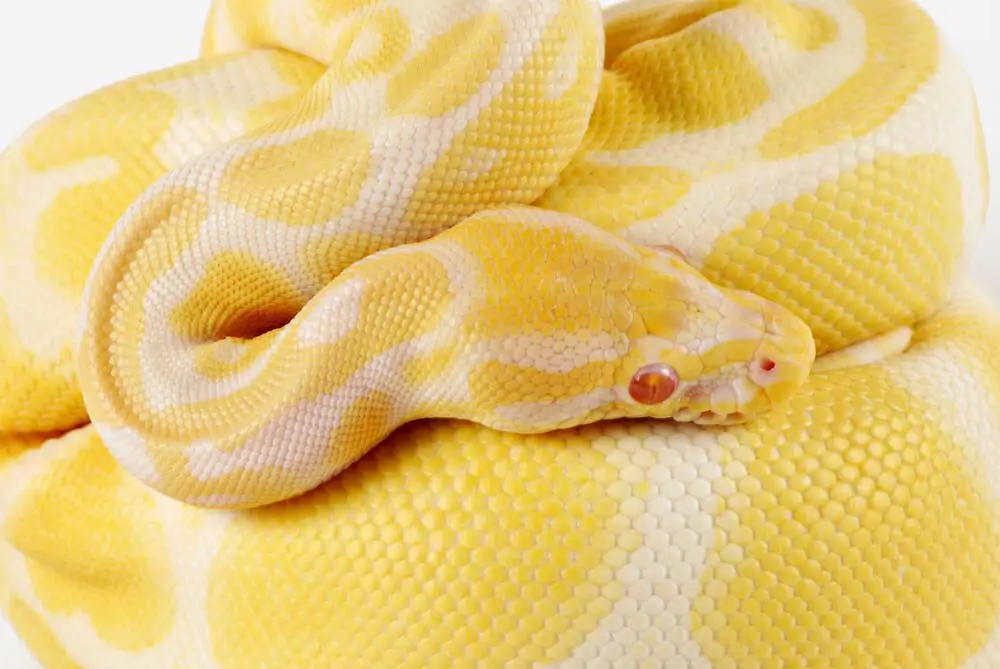Despite its relative scarcity, the albino ball python is a popular pet amongst beginner reptile owners and veterans alike.
It’s beautiful coloring, docile temperament, and straightforward care requirements make it an attractive reptile.
| Common Name: | Ball Python |
| Scientific Name: | Python regius |
| Natural Habitat: | Central and Western Africa |
| Adult Size: | 3 – 5 Feet |
| Lifespan: | 20 – 30 Years |
| Diet: | Rodents |
| Experience Level: | All Levels; Beginner – Expert |
| Enclosure Size: | At Least 50 Gallons |
Reptile Overview
The albino ball python is extraordinary for its coloring and difficult breeding requirements. But beyond this, it’s like many other ball pythons and snakes.
As an adult, this snake needs at least a 50-gallon enclosure with a temperature gradient of 75 – 85 degrees Fahrenheit and humidity between 45 – 75%.
Albino ball pythons need daily access to water and a frozen mouse or rat roughly once per week.
It can grow up to 5 feet and live up to 30 years, meaning that interested owners should be prepared for a long-term commitment.
With regular handling and proper care, albino ball pythons are a lifelong companion that require minimal upkeep and provide lots of love.
Appearance
The albino ball python is a natural color morph of the common ball python and the most common color variant in captivity.
Their coloring is the result of a recessive mutation of the ball python. They have the same pattern of the ball python, but their colors are amelanistic.
This means that they lack melanin or dark pigmentation. They are typically white with pale yellow patterns, or a cream/ light pink color with dark yellow or orange patterns.
There are two types of albinism in ball pythons: T+ (tyrosinase-positive) and T- (tyrosinase-negative); the former have dark-colored eyes and tongues, while the latter have red or pink eyes and tongues.
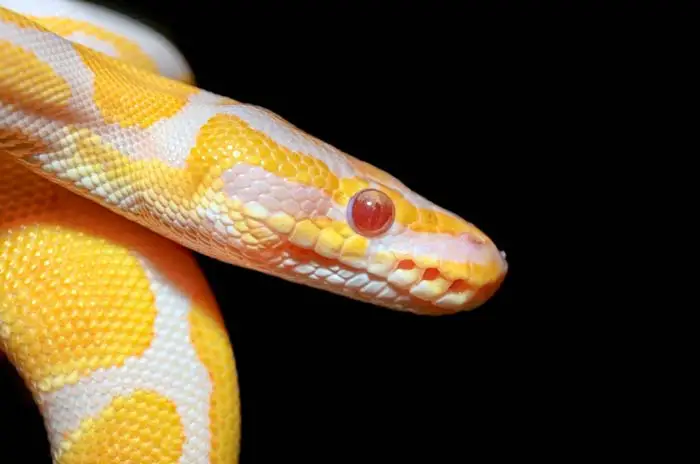
Juveniles’ coloring will often start out darker and lighten with age.
Because of its popularity, it has been further bred to emphasize various color variations, producing further morphs. These include the lavender albino ball python, pied albino ball python, banana albino ball python, and camel albino ball python, among others.
Albino ball pythons grow anywhere from 3 – 5 feet long. Females are typically a few inches longer than males, but the difference is minute and not a reliable way to distinguish sex.
Instead, probing is the best method to figure out if you have a male or female.
They have long, broad bodies with small heads and move in rectilinear patterns rather than straight lines.
Price & Availability
Appearance is often the deciding factor for a ball python’s price, which is why morphs tend to cost more. Whereas an albino ball python costs approximately $400, a lavender piebald ball python may cost upwards of $1,000.
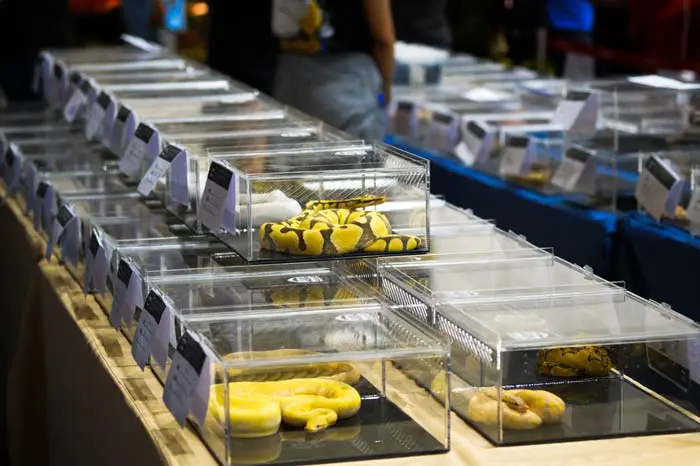
Lavender albino ball pythons specifically are so expensive because their specific color variation is harder to produce. This morph has a lavender base color with yellow patterning.
The high prices are also driven by the relative difficulty of breeding. The popularity of albino ball pythons create high demand, but there is limited supply.
Morphs are even scarcer than regular albino ball pythons and therefore pricier.
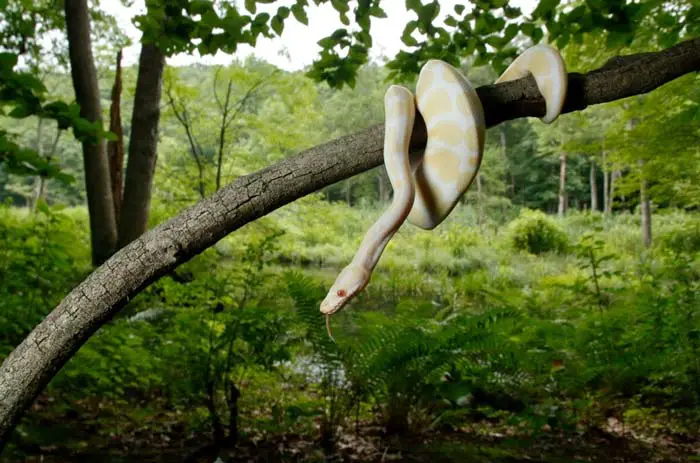
The availability of albino ball pythons and morphs grows even slimmer when people limit their searches to reputable breeders that offer health guarantees.
Though albino ball pythons are a natural color variant and therefore can occur in the wild, they are more rare.
Instead, the vast majority of albino pythons are captive-bred. Morph variants are exclusively captive-bred.
Behavior & Temperament
Albino ball pythons are naturally laidback but will become very docile with regular handling and socialization.
As hatchlings and juveniles, they tend to be more nervous and prone to defensive behavior, such as curling into a tight ball. They are not known for biting and must be severely provoked to lash out.

But with a regular handling schedule, they can soon become used to being picked up.
Expert Tip: Don’t clench your python or try to strain their movements; allow them to move freely around your hands and arms. The key is to support your snake, not control it.
They tend to be less active during the day, and instead prefer to explore their enclosure around dawn or dusk or at night. Similarly, this is also when they prefer to be fed.
Lifespan
Albino ball pythons have an average lifespan of 20 – 30 years. Obviously, their care has a direct impact on this.
Owners that offer reliable care and a proper enclosure, diet, etc. will have pythons that last much longer than owners that don’t provide their snakes with the necessary temperatures, humidity, etc.
Enclosure
Ball pythons are terrestrial, meaning horizontal space is more important than vertical space (i.e., length over height). However, they can still enjoy some semi-arboreal décor, such as sandblasted driftwood.
Hatchlings and juveniles can thrive in a 20-gallon setup, but adult albino ball pythons will need at least 50 gallons. But when it comes to enclosures for these pythons, bigger is always better.
REPTI ZOO Large Glass Reptile Terrarium
Terrariums, glass or acrylic tanks, and rack systems are all suitable enclosures that albino ball pythons can thrive in.
A great rule of thumb is to house your python in an enclosure that’s big enough for them to completely stretch out in, without bending or curving their body.
Newspaper or paper towels are often the best substrate for young snakes. This type of lining is easily replaced to prevent disease during the critical first stages of a python’s life.
But mature pythons do better with substrate like cypress mulch or aspen bedding. Never use oily woods like pine or abrasive substrate that may damage your snake’s underbelly.
Commercial, DIY, and store-bought substrates can be packed roughly 3 inches deep; bioactive setups will need to have at least 5 – 6 inches of substrate.
Hides are absolutely necessary for this snake. Like most ball pythons, the albino variant is timid and not very active during the day.
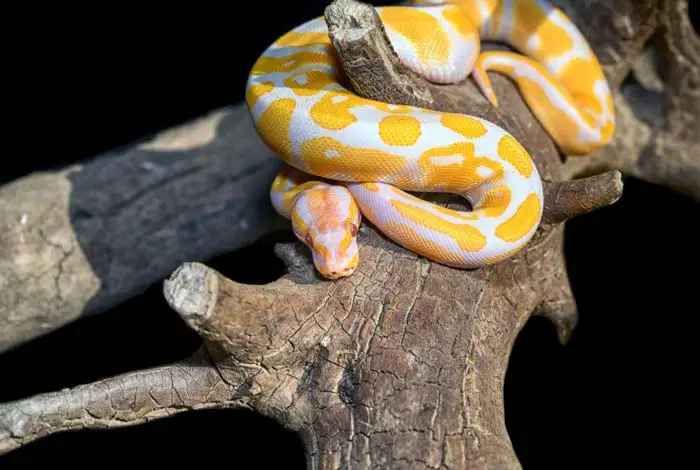
You’ll need at least three hides: one for each end of the temperature variant (discussed in the next section) and a humidity hide to help with sheds.
Hides should be smaller rather than larger; to feel secure, ball pythons tend to wedge themselves into hiding places and curl up.
Make sure a large, shallow water dish is included in your python’s enclosure. They enjoy curling up and soaking, so the dish should be sizeable enough to allow this.
Provide your python with fresh water every day. This will get rid of any substrate tracked into the dish during soaking periods and also prevent algae and other accumulations.
The water should be treated with a conditioner to neutralize any chemicals present, such as chlorine.
Temperature & Lighting
Your albino ball python’s enclosure should have a temperature gradient of 75 – 85 degrees Fahrenheit, with an additional basking spot of 90 degrees.
During the night, they can tolerate a 5-degree drop in temperature across the enclosure, creating a variant of 70 – 80 degrees Fahrenheit.
To establish the temperature gradient, place a heating pad externally near a corner of the enclosure.
VIVOSUN Reptile Heating Pad with Digital Thermostat
Then, if you’re using a tank or terrarium, add a day heat bulb to whichever side the other heating element is on.
Along with a targeted basking bulb, this will create the “hot” side of your tank. Your snake will migrate in and out of the “hot” and “cold” sides as it regulates its temperature.
At night, you can either turn the lights off or use a ceramic heat emitter or night heat bulb to maintain a safe temperature gradient, just do not forget to cover it to avoid any burns!
Humidity
The ideal humidity for an albino ball python is 45 – 75%. Keeping a water dish on the “hot” side of the tank will help with this, as can adding moisture-retaining materials like sphagnum moss to your substrate.
Galápagos Terrarium Sphagnum Moss
In addition to or instead of a regular water dish, some owners prefer to add a waterfall or similar water feature to the enclosure. Not only does this help with humidity, but running water will entice your snake to drink more than stagnant water.
The substrate itself should also be able to hold some humidity, if necessary. You can also regularly spray down the enclosure or add a misting/ fogging system.
While ventilation is necessary for your enclosure, it can make maintaining the humidity for your python more difficult.
Diet
Albino ball pythons are primarily fed on rodents, either mice or rats depending on the age, size, and health of the individual snake.
You can also supplement your python’s diet with prey such as gerbils, hamsters, rabbits, quail, and even guinea pigs.
Make sure the prey isn’t larger than the widest part of your python. To avoid potential injuries and disease, we recommend feeding your snake pre-killed and thawed prey.
Hatchlings and juveniles should be fed once per week, while adults can be fed every 7 – 10 days.
Since albino ball pythons are nocturnal, it’s better to feed them in the evenings or nights.
Refrain from handling your python 12 hours before and 12 hours after feeding.
Albino ball pythons will often refuse food if they’ve been handled before feeding. They’re also more likely to become defensive or regurgitate their food if you try to handle them soon after feeding.
Therefore, it’s best to abstain from handling them altogether for a 24-hour period.
Similarly, albino pythons are known for also refusing to eat because of habitat changes and environmental disruptions.
Potential Health Issues
Because albino ball pythons and morphs are nearly all captive-bred, they suffer from less diseases than their wild-caught counterparts. However, they are still susceptible to several health issues.
These include:
- Mouth Rot – If your snake isn’t shutting their mouth or you notice discolored gums (any color other than light pink), they may have infective stomatitis, also known as mouth rot.
- Respiratory Illnesses – This is what happens when you combine cool temperatures and high humidity; symptoms include gasping and bubbles or discharge from the nose.
- Dermal Fungal Infections – This is also caused by cool temperatures and humidity; it causes skin lesions that may become crusted or bloody.
- Mites – These small parasites often appear on imported pythons or snakes from breeders with an infestation. Look for excessive soaking and small “bugs” on the eyes and mouth.
If you suspect your albino ball python has a health issue, schedule an appointment with an exotics-certified veterinarian immediately.
Breeding
Breeding albino ball pythons and morph variants like lavender albino ball python can be long and difficult.
Albino ball pythons don’t reach sexual maturity until well into adulthood, anywhere from 2 – 3 ½ years old. Compared to other ball pythons, this is relatively advanced.
The breeding process itself takes nearly an entire year, more if you consider preparation for breeding.
To prepare ball pythons for breeding, drop temperatures to mimic their natural habitat. In the wild, ball pythons mate during the cool, rainy season; while increasing the humidity will cause respiratory problems, dropping the temperature is safe.
You’ll also need to increase your feeding schedule to make sure the breeding pair is well-fed and satisfied.
Complicating matters is the fact that many albino ball python eggs are infertile. Unfortunately, there’s nothing you can do to increase fertility rates; it all depends on the mating pair.
Eggs that are viable are part of small clutches of less than 10 eggs. Typically, females lay only 4 – 8 eggs.
The eggs must be incubated for approximately 50 – 60 days by either the female in a nest box or an incubator.
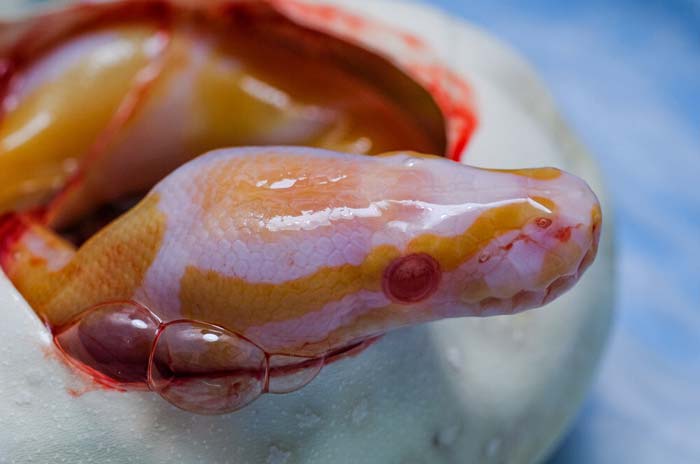
Incubating them in a mixture of damp vermiculite helps keep them insulated and safe. They’ll need to be kept warm as well, at 82 – 86 degrees Fahrenheit until hatching.
Conclusion
In many respects, the albino ball python is like other ball pythons; it has straightforward care requirements, an average lifespan of 20 – 30 years, and grows to moderate size of 3 – 5 feet.
Beyond this, albino pythons are extremely docile and take well to handling, meaning these pythons are great pets for both beginners and experienced owners.
Unfortunately, its striking coloration and notorious breeding difficulties mean that its availability often outpaces demand.
But for owners who are willing to dedicate their time, money, and love, albino ball pythons are the perfect reptile.
Related:

